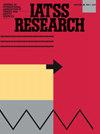分心还是长时间等待?对危险过马路行为的影响
IF 3.3
Q3 TRANSPORTATION
引用次数: 0
摘要
行人与车辆在十字路口的冲突被认为是造成伤亡的主要原因。十字路口是道路设计的关键部分,因为由于十字路口的设计方式,行人暴露在不同的潜在危险活动中,而且行人正在做什么以及他们在城市中的位置。在这项研究中,各种影响危险的交叉行为进行了检查。在个人层面上,测试了分心的影响和人们在过马路前看的地方。此外,各种十字路口的设计变量,包括等待时间,十字路口的大小和速度限制,以及上下文变量,如附近的建筑环境和交通流量进行了检查。这些数据是通过观察蒙特利尔和魁北克市24个十字路口(每个路口12个)的行人收集的。估计逻辑回归模型以确定四种危险行为的影响变量:a)开始时为红色,b)结束时为红色,c)开始时为绿色,结束时为红色,d)完全越过红色。结果表明,等待时间对短等待时间(<;30年代)大大减少了这种行为的可能性。就个人行为而言,手里拿着手机会减少开始闯红灯的可能性。相比之下,看交通状况与非法越境的关联要高出四倍以上。本文章由计算机程序翻译,如有差异,请以英文原文为准。
Distractions or long waits? Impacts on risky crossing behaviour
Pedestrian-vehicle conflicts at intersections are considered as a major source of injuries and fatalities. Intersections are a critical part of roadway design since pedestrians are exposed to different and potentially dangerous activities due to how an intersection is designed, but also what the pedestrian is doing and where in the city they are. In this study, various influences on risky crossing behaviour are examined. At the individual level, the influence of distractions and where people are looking before crossing are tested. Further, various intersection design variables including wait time, intersection size and speed limits, and contextual variables such as the built environment nearby and traffic flow are examined. The data was gathered by observing pedestrians at 24 intersections in Montreal and Quebec City (12 each). Logistic regression models were estimated to determine the influencing variables on four dangerous behaviours: a) start on red, b) finish on red, c) finish on red having started on green, and d) cross completely on red. Results demonstrate the importance of wait time on risky crossing behaviour with short wait times (< 30s) decreasing the likelihood of such behaviours considerably. For individual behaviour, having a cellphone in one's hand reduces the likelihood of starting to cross on red. In contrast, looking at traffic was over four times more associated with crossing illegally.
求助全文
通过发布文献求助,成功后即可免费获取论文全文。
去求助
来源期刊

IATSS Research
TRANSPORTATION-
CiteScore
6.40
自引率
6.20%
发文量
44
审稿时长
42 weeks
期刊介绍:
First published in 1977 as an international journal sponsored by the International Association of Traffic and Safety Sciences, IATSS Research has contributed to the dissemination of interdisciplinary wisdom on ideal mobility, particularly in Asia. IATSS Research is an international refereed journal providing a platform for the exchange of scientific findings on transportation and safety across a wide range of academic fields, with particular emphasis on the links between scientific findings and practice in society and cultural contexts. IATSS Research welcomes submission of original research articles and reviews that satisfy the following conditions: 1.Relevant to transportation and safety, and the multiple impacts of transportation systems on security, human health, and the environment. 2.Contains important policy and practical implications based on scientific evidence in the applicable academic field. In addition to welcoming general submissions, IATSS Research occasionally plans and publishes special feature sections and special issues composed of invited articles addressing specific topics.
 求助内容:
求助内容: 应助结果提醒方式:
应助结果提醒方式:


